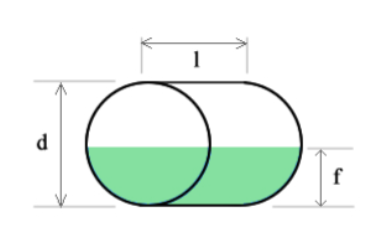Horizontal Cylinder Tank Volume Calculator

Total Volume of the Horizontal Cylinder Tank
The total volume \( V_{\text{tank}} \) of a cylinder-shaped tank is determined by multiplying the area \( A \) of its circular end by its length \( l \). The area \( A \) of the circular end is given by \( \pi r^2 \), where \( r \) is the radius, which is equal to half the diameter or \( \frac{d}{2} \). Thus, the total volume of the tank is:
To calculate the filled volume of a horizontal cylinder tank, we first need to find the area \( A \) of the circular segment that corresponds to the filled portion and then multiply it by the length \( l \).
For a circular segment, the shaded area \( A \) is given by:
where \( \theta \) is in radians and is calculated as:
Here, \( m \) represents the vertical distance from the center of the circle to the chord defining the segment's base.
Thus, the volume of the circular segment \( V_{\text{segment}} \) is:
If the fill height \( f \) is less than half the diameter \( d \) (i.e., \( f < \frac{d}{2} \)), we use the segment created by the filled height directly, and the filled volume \( V_{\text{fill}} \) is:
However, if the fill height \( f \) is greater than half the diameter \( d \) (i.e., \( f > \frac{d}{2} \)), we need to calculate the segment corresponding to the empty portion of the tank and subtract it from the total volume to get the filled volume. In this case:
where \( V_{\text{segment}} \) now represents the volume of the empty segment.
 Home
Home Back
Back